I could not let October slide without writing a post on the topic of Breast Cancer Awareness, as it is the designated month of the year for more a decade now, for raising awareness on this serious disease.
So I thought, let's use Steemit for our share of raising awareness on this potentially life threatening disease, and spread the message globally while personally further researching and learning about the topic's intricacies.
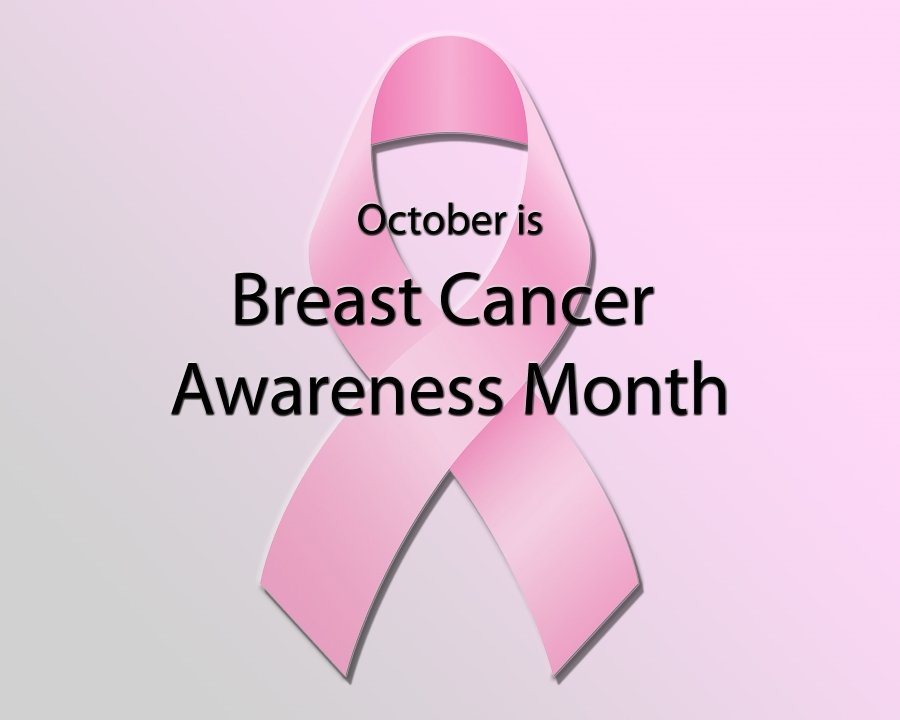
What is Breast Cancer?
Breast cancer is a type of malignant tumor that grows within the tissues of the breast. Essentially, DNA mutations cause cells to become malignant, and grow extensively while potentially invading the surrounding tissues or even spreading to other bodily areas.
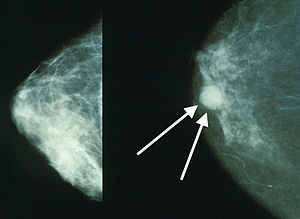
Breast cancer can occur in different variations. The most common type originates from milk carrying ducts to nipples (often referred to as ductal carcinoma). Alternatively another type starts from milk creating glands (referred to as lobular carcinoma). Other types of breast cancer are less common, and in some cases can even originate from other parts of the body (such as sarcomas and lymphomas) while not really identified as breast cancers.
What are the common symptoms?
Not every breast cancer causes a lump. Some cases can be detected in earlier stages via mammograms before symptoms can arise, such as a felt lump. Some of the most common symptoms include:
- a lump that is felt in the breast. Almost 80% of breast cancer cases are detected as such.
- armpit or breast pain
- an inverted nipple or one that has changed position.
- a change in breast size or shape .
- nipple rash
- nipple discharge, often including blood
- change in the skin of the breast or nipple such as peeling, flaking, itching (often referred to as Paget's disease of the breast)
Illustration of some early symptoms
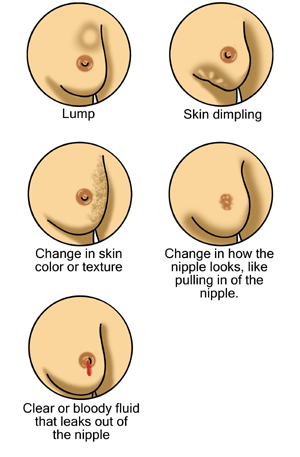
While most breast lumps are harmless, with less than 20% being cancerous, yet it is essential and potentially life saving to consult a physician upon any such symptoms.
What are the population risk stats and mortality rates?
The rate for developing breast cancer at the moment is at 12% worldwide, with a similar 12% in the US, meaning 1 out of 8 women are at risk, making it the most common cancer for women, after skin cancer.
For death risk, breast cancer is the second leading cause of cancer death among women, right after lung cancer. The likelihood of a woman dying from breast cancer is at a rate of 1 out of 37 (roughly 2.7%). It is estimated that in 40,610 women in the US alone will die from breast cancer in 2017.
While some argue that mammographic screening tests could be causing more harm than good, yet the official reports (cancer.gov) is that women between 40 and 74 who perform screening have less chance of dying from breast cancer than ones who do not.
And the general consensus is that through increased awareness, treatment, (and screening), death rates across the years have dropped around 39% from 1989 to 2015.
What are the Risk Factors?
The most common risk factors are gender and age.
Generally speaking, a female with older age is at a higher risk.
Additional risk factors include genetics, no history of breastfeeding and childbearing, hormonal imbalances, bad dietary choices, and obesity. In details:
- Age: a 20 year old female has a risk of around 0.6%. At 70, the risk grows to 3.84%
- Genetics: having relatives who suffered from the disease is an increased risk factor. Similarly carrying BRCA1 and BRCA2 genes, or TP53 gene is generally related to higher risk.
- Prior Breast Cancer: having suffered from a prior case of breast cancer (or even a benign lump) is also a risk factor for a recurring case.
- Estrogen Exposure: Women exposed to higher lapses of increased estrogen levels are considered at higher risk. Those include women who have earlier starting periods, or later menopause. Breast-feeding on the other hand is considered to reduce the risk due to lowered estrogen levels, especially if feeding for one year.
- Body Weight: High fat diets, high alcohol intake, high cholesterol levels, sugar high diets, and overall obesity are all generally associated with increased risk levels. One fact regarding alcohol consumption is that women with 3+ drinks in a day have 1.5 times higher risk levels.
- Radiation: Being exposed prior to radiation, and in cases other than breast cancer, is considered a higher risk.
- Hormone Treatment: Subduing specific hormonal treatments, including using contraceptive pills has been linked by some studies to breast cancer as well.
- General lifestyle: In addition to the body weight point above, a sedentary lifestyle is linked to around 10% of breast cancer cases. Tobacco consumption is also a major risk factor, that could jump the rates to around 35-50%.
While prevention cannot be necessarily accomplished, yet consuming a healthy and active lifestyle, breastfeeding where applies, and early diagnosis are often key measures that contribute to prevention.
How is it diagnosed?
Several diagnostic tests can be done either at home, clinic or hospital for proper diagnosis and detection, including:
- Physical Breast Exam: A manual checkup of the breast by contact to detect any lumps or other symptoms. This is either performed at home as a first phase - normally recommended on a monthly basis, and at a physician in case of concerns (or at least once or twice a year).
A useful video for detecting symptoms and personal diagnosis via Physical Exam

- Mammography: Being the most common detection test, in which an X-ray of the breast is conducted for detecting any lumps. This can even allow earlier detection and manual checkup. At this stage, detecting a lump is not always indicative of cancer, and requires further checkup such as via Ultrasound of MRI . Also for women under the age of 50, this test could fall short on detecting tumors due to dense breast tissues in younger women.
Screening recommendations in line with above statement are as follows, as found under wikipedia (source 1):
For the average woman, the U.S. Preventive Services Task Force recommends mammography every two years in women between the ages of 50 and 74, the Council of Europe recommends mammography between 50 and 69 with most programs using a 2-year frequency, and in Canada screening is recommended between the ages of 50 and 74 at a frequency of 2 to 3 years
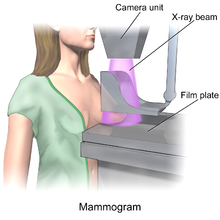
- Biopsy
Which is basically extracting tissue for lab tests and confirmation of the nature of the lump by lab tests.
Biopsy
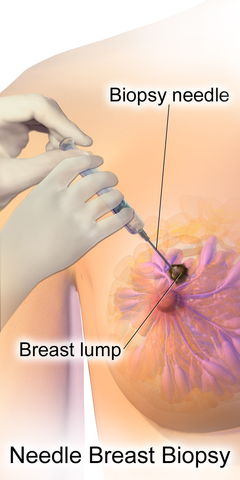
Treatment and chance of recovery
Treatment and chance of recovery depend on several factors, including the type and stage of breast cancer, speed of growth, recurrence possibility, hormonal sensitivity, as well as age and health status of the patient.
Key treatments include (can be a combination of one or more):
- Radiation therapy: whereby doses of radiation are applied at the affected area to destroy cancerous cells. Sessions last for few minutes, but could expand 3-5 weeks, for 3-6 weeks.
- Surgery: more on this below.
- Biological therapy: Involves utilization of drugs that target specific types of cancer, including Herceptin, Tykerb...
- Hormone therapy: Normally used to prevent recurrence of cancer post surgery.
- Chemotherapy: Normally applied for 3-6 months using cytotoxic drugs. This is also helpful in cases of spread or metastasized cancer.
The most common approach is surgery, followed by chemo and/or radiation therapy. With surgery, the process involves removing the cancerous cells along with neighboring normal tissue. This comes under three types:
- Lumpectomy: where a small part of the breast is removed.
- Quadrantectomy: where one-quarter of the breast is removed.
- Mastectomy: involving full breast removal.
This could then be followed by breast reconstruction surgery.
A female only disease?
That is not accurate. While mostly women are affected by this cancer, yet also men can be susceptible to this disease, while at much lower risk rates, with less than 1% of cases occurring in men.
Further Readings
To learn further about the topic, feel free to check out any of the references enlisted below, as they contain tons of information on the topic.
Thank you for reading through, and hope this helps someone somewhere via raising proper awareness.
References:
- https://en.wikipedia.org/wiki/Breast_cancer
- https://www.cancer.org/cancer/breast-cancer/ (and related sub-pages under topic)
- https://www.cancer.gov/types/breast/patient/breast-screening-pdq
- https://www.cancer.gov/about-cancer/screening/patient-screening-overview-pdq
- https://www.medicalnewstoday.com/articles/37136.php
- http://www.breastcancer.org/symptoms/types/male_bc
Photo Credits:
A Proud member of steemSTEM
SteemSTEM is a project that aims to increase both the quality as well as visibility of Science, Technology, Engineering and Mathematics (and Health). You can check out some great scientific articles via visiting the project tag #steemSTEM , project page @steemstem, or connecting with us on chat https://steemit.chat/channel/steemSTEM
A Proud member of MAP (Minnows Accelerator Project)
MAP is a growing community helping talented minnows accelerate their growth on Steemit.
To join, check out the link at the home page of @accelerator account
Recent Prior Posts
- Day 2 of my #sevendaybnwchallenge photography
- Liquid Helium: That Super Fluid!
- Day 1 of my #sevendaybnwchallenge photography
- Would You Swallow A Battery ?
- Idée Fausse #9: La couleur du mucus détermine si vous avez besoin d'antibiotiques (et certains médecins la croient encore)
- Amazing Inventions of the Past: The Elephant Clock
- Idée Fausse #8: La césarienne prends son nom après Jules César
- What Do You Know About Time Crystals - The Newest State Of Matter?
- Idée Fausse #7: Néron avait enflammé Rome et la regardait brûler
- Idée Fausse #6: Les Chocs à Basse Tension ne Sont pas Dangereux
